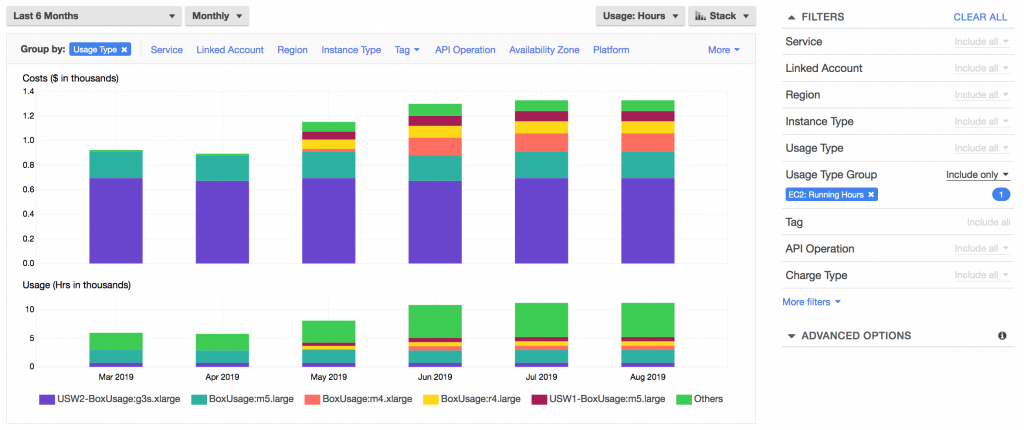AWS Cloud Financial Management
Tips and Tricks for Exploring your Data in AWS Cost Explorer
When it comes to operating in the cloud, it’s always best to have more information than you need. Last time I covered how anyone can get started slicing and dicing AWS cost and usage information using AWS Cost Explorer, but what happens when you need to dive even deeper into your cost and usage data? This is a concept that we explored at length at last week’s AWS Cost Management Workshop at the AWS Loft in New York City.
In this post, I discuss some helpful tips and tricks for diving deeper into your costs and usage to helping you take your service-, account-, or AWS Region-based reports to the next level.
You can follow along by navigating to Cost Explorer, and choosing Explore, then Costs & Usage.
Tip #1: Leveraging usage type groups
In the previous post, I showed you how to filter and group your data by Linked Account, Region, and Instance Type to gain more insight into your costs. One often-overlooked benefit of using Cost Explorer is that it allows you to analyze your usage at the same time. One of the easiest ways to do this is to adjust your filters to return a specific Usage Type Group or Usage Type. If all costs have the same corresponding unit of usage, then the usage chart appears beneath the cost chart.
Usage types are the units of usage that AWS services track for individual resources. Usage type groups are a bundle of related usage types that Cost Explorer bundles into a single filter, making it quicker and easier to examine specific facets of your AWS usage. You can see the following example of EC2 cost and usage data.
In general, I recommend examining the usage types with a low amount of usage in the chart and cross-referencing that usage against the cost in the top chart. You can also do this from the table view beneath the chart.
Usage type groups are supported for the Amazon EC2, Amazon S3, and Amazon DynamoDB services. For a full list of usage type groups, see Filtering the Data That You Want to View.

Build this report: Filter your report to the EC2: Running Hours usage type group and group by Usage Type.
Tip #2: Understanding the EC2-Other service category
Amazon EC2 is one of the most popular AWS services. In the past, AWS observed that most customers prefer to track their compute hourly costs separately from some of EC2’s integration points with other services. To support this, AWS created multiple categories of usage, including the following:
- EC2 Container Service
- EC2 Container Registry
- EC2 Elastic Load Balancing
- EC2-Other
In the past, many financial analysts and DevOps engineers have asked for more context into specialized aspects of EC2 service usage. They cite one of these service categories as particularly helpful—specifically the EC2-Other service category. The EC2-Other category includes multiple service-related usage types, tracking costs associated Amazon EBS volumes and snapshots, elastic IP addresses, NAT gateways, data transfer, and more.
These EC2-specific service categories can help you quickly move between the totality of your EC2 footprint and dive into some of the supplemental usage aspects that benefit from a closer look (for example, EBS snapshot costs).

Build this report: Filter your report to the EC2-Other service category and group by Usage Type.
Tip #3: Using the Purchase Option filtering and grouping dimension
For those of you who already purchased AWS Reservations (such as Amazon EC2 Reserved Instances) or Amazon EC2 Spot Instances, the Purchase Option grouping and filtering dimension might be your new best friend.

Build this report: Filter your report to the EC2: Running Hours usage type group and group by Purchase Option.
Tip #4: Diving deeper into your tagged costs
AWS provides you with the ability to define and apply resource tags from the Tag Editor or individual service consoles. You can activate these tags can for cost allocation purposes in the Billing console. Those tagged groups are essential to understanding key facets of your organization’s cost footprint. It makes sense to examine the individual APIs your usage triggers in addition to the specific Usage Type.

Build this report: Filter your report to a particular tag key and value pair and group by API Operation.
Conclusion
Cost Explorer provides you with multiple filtering and grouping dimensions that allow you to sort your cost and usage data for easy review. This post summarizes some of the most commonly requested report use cases. It also provides some helpful hints for diving deeper into your costs and usage on your own. You can learn more about AWS Cost Explorer here.
Oh, and before we forget, here’s a quick snapshot of the team at last week’s event!
